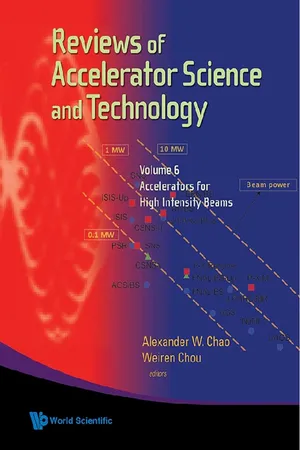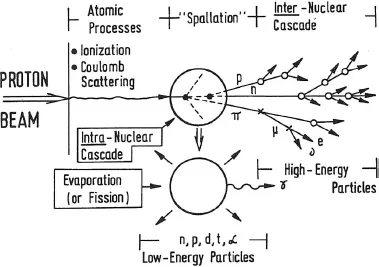![]()
| Reviews of Accelerator Science and Technology Vol. 6 (2013) 59–83 © World Scientific Publishing Company DOI: 10.1142/S1793626813300041 | |
Spallation Neutron Sources and Accelerator-Driven Systems
Stuart D. Henderson
Fermi National Accelerator Laboratory,
P. O. Box 500, MS105,
Batavia, IL 60510, USA
Spallation neutron sources are the primary accelerator-driven source of intense neutrons. They require high power proton accelerators in the GeV energy range coupled to heavy metal targets for efficient neutron production. They form the basis of large scale neutron scattering facilities, and are essential elements in accelerator-driven subcritical reactors. Demanding technology has been developed which is enabling the next generation of spallation neutron sources to reach even higher neutron fluxes. This technology sets the stage for future deployment in accelerator-driven systems and neutron sources for nuclear material irradiation.
Keywords: Accelerator; spallation; neutron source; subcritical reactor.
1. Introduction
The nuclear spallation reaction [1] provides an efficient mechanism for the production of copious high energy neutrons from GeV energy protons. Neutron sources which utilize the spallation process form the basis of large scale accelerator-based neutron scattering facilities, several of which are in operation or under construction throughout the world [2]. Spallation sources are capable of delivering higher pulsed neutron fluxes than conventional reactor-based sources, making them the technology of choice for modern neutron scattering facilities [3]. Due to the high flux of fast neutrons that can be produced with spallation sources, they have attracted considerable attention for their application in accelerator-driven subcritical nuclear reactors and for material irradiation facilities.
Neutrons are produced by the interaction of a GeV energy high power proton beam with a heavy metal target. Neutron production is quite efficient; for a lead target, approximately 20 neutrons are produced per 1 GeV proton. Approximately half of the incident proton energy is absorbed in the target.
In contrast to spallation sources, fission reactors are neutron-poor. In the fission of 235U, which produces ∼2.5 neutrons/fission, only ∼1 neutron is available for external use, 1 being required to sustain the reaction and 0.5 being lost. Since each fission reaction releases ∼200MeV of energy, the thermal energy released per neutron is about one order of magnitude higher for reactor-based sources than for spallation sources. Reactor technology, having reached the practical limits of heat removal from the core, is limited in terms of neutron flux that can be achieved.
With a spallation source it is possible to impress a time structure on the neutron flux by using a pulsed proton source, a feature which is exploited in pulsed spallation sources in which the peak flux achieved is several orders of magnitude higher than the average flux. With pulsed neutrons it is possible to use time-of-flight measurements to determine the incident neutron energy, which provides essential kinematic information for neutron scattering measurements.
The highest flux reactor-based sources reach thermal neutron fluxes of ∼1.3 × 1015 neutrons/ cm2/s. Pulsed spallation sources reach peak thermal neutron fluxes of 1016 neutrons/cm2/s, nearly an order of magnitude higher.
Spallation neutron sources are characterized by their time structure. Continuous neutron sources utilize continuous proton beams, which can be produced by a cyclotron or a continuous wave superconducting linear accelerator. A short pulse spallation source utilizes a long pulse high intensity proton linear accelerator, the beam from which is accumulated over many turns in a synchrotron or accumulator ring and then extracted in a single turn. The proton time structure is therefore short in duration, less than the revolution time in the ring, which is typically 1 μs. In an intermediate approach, a long beam pulse may be delivered from a high intensity linear accelerator with pulse duration of order 1ms. The need to perform time-of-flight measurements from pulsed neutron sources requires a small beam pulse repetition rate, typically less than 60 pulses per second, in order to avoid the “frame overlap” problem, which arises when faster neutrons arrive at the experimental apparatus in time with slower neutrons from the previous pulse.
Target systems have ranged from solid metal to closed loop liquid metal systems, to rotating solid systems. For neutron scattering applications, the spallation target is surrounded by a moderator which delivers a thermalized neutron flux tailored for use in materials science measurements. The target system is part of a target core which includes the neutron moderators and massive shielding.
Spallation neutron sources operating today cover the range from ∼100kW to more than 1MW in beam power, with systems under design for as much as 5MW of beam power.
2. Nuclear Spallation Process
Spallation, a term coined by Glenn Seaborg in his Ph.D. thesis [1], is a process in which a light particle with energy greater than ∼100MeV strikes a heavy nucleus with the resulting emission of nucleons (“spalled” particles) through nuclear cascade, evaporation and fission processes. The process is quite efficient for the generation of neutrons. As an example, bombardment of a lead nucleus by 1 GeV protons results in the emission of ∼20 neutrons per incident proton. The resulting spallation residue nucleus is of significantly smaller atomic number. The nuclear spallation process is described in Refs. 4–6.
Fig. 1. Schematic diagram of the nuclear spallation process. (Reprinted from Ref. 5.)
Spallation is a complex, multistep process, in which an incident high energy particle collides with a nucleus, exciting the nucleus, which ejects nucleons and particles that subsequently interact with other nuclei in a cascade. A thorough discussion is available in Ref. 7. The process is shown schematically in Fig. 1. The incident proton collides with individual nucleons in the nucleus, imparting kinetic energy to individual nucleons, and occasionally ejecting nucleons which subsequently interact with surrounding nuclei. This intranuclear cascade results eventually in heating of the nucleus due to secondary and tertiary collisions. This excited nuclear state decays via nucleon evaporation and fission. The interaction of escaping nucleons with the surrounding nuclei, called the internuclear cascade, continues the process, with the net result of the emission of a high flux of neutrons and other low energy particles and fragments. The spallation process and neutron transport is modeled in several Monte Carlo codes, for example MCNPX [8].
The most important features of the spallation process from the point of view of spallation neutron sources are summarized here. A thorough discussion is available in Refs. 5 and 7. The neutron spectrum peaks in the MeV range, but extends all the way up to the primary proton energy, as shown in Fig. 2, which compares neutron spectra for two metal target materials. For low energy neutron scattering research, high energy neutrons are moderated in ambient temperature or cryogenic moderator systems.
The neutron yield per proton is an important quantity for spallation neutron source design. Figure 3 sh...


